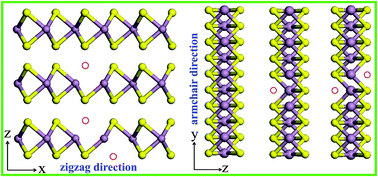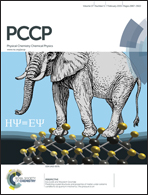Stabilities and electronic properties of monolayer MoS2 with one or two sulfur line vacancy defects
Abstract
Stimulated by the recent experimental observation that single sulfur vacancies in monolayer MoS2 are mobile under the electron beam and easily agglomerate into the sulfur line vacancy defects [Phys. Rev. B: Condens. Matter Mater. Phys., 2013, 88, 035301], the stabilities and electronic properties of monolayer MoS2 with one or two staggered sulfur line vacancy defects (SV or DV), along the armchair or zigzag direction (AC–SV, AC–DV or ZZ–SV, ZZ–DV), have been investigated systematically by first-principles calculations. It is found that: (1) The ZZ-types (ZZ–SV and ZZ–DV) are more stable at different line vacancy densities than the AC-types (AC–SV and AC–DV), which is in good agreement with previous experimental findings. (2) More interestingly, it is predicted from our numerical calculations that, in the same ZZ-types, the ZZ–DV is more stable than the ZZ–SV, indicating that two separate ZZ–SV line vacancy defects tend to move closely to each other for coalescing into a ZZ–DV, which is in contrast to the AC-type with AC–SV being a little more stable than the AC–DV. (3) The monolayer MoS2 with the AC–SV or AC–DV are both semiconductors with a direct or an indirect band gap, respectively, both of which are significantly smaller than that of the perfect monolayer. (4) Furthermore, the out-of-plane distortion induced by strain release in the monolayer MoS2 with ZZ–SV or ZZ–DV is more severe than that with the AC-type, which can further considerably decrease the system's gap value or even make the gap nearly closed. Our calculation results will be helpful in future nanoelectronics and nanoelectromechanics based on MoS2 materials.


 Please wait while we load your content...
Please wait while we load your content...